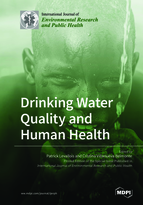Drinking Water Quality and Human Health
A special issue of International Journal of Environmental Research and Public Health (ISSN 1660-4601). This special issue belongs to the section "Environmental Health".
Deadline for manuscript submissions: closed (30 June 2018) | Viewed by 159266
Special Issue Editors
Département de médecine sociale et préventive, Faculté de médecine, Université Laval, Québec, QC, Canada
Interests: health impact of chemical and microbiological contamination of drinking water, drinking water standards, risk analysis, environmental epidemiology
Special Issue Information
Dear Colleagues,
Quality of drinking water is paramount for public health. Despite important improvements in the last decades, access to safe drinking water is not universal. The World Health Organization estimates that almost 10% of the population in the world do not have access to improved drinking water sources. Among other diseases, waterborne infections cause diarrhoea, which kills nearly one million people every year, mostly children under 5 years of age. On the other hand, chemical pollution is a concern in high-income countries and an increasing problem in low- and middle-income countries. Exposure to chemicals in drinking water may lead to a range of chronic non-communicable diseases (e.g., cancer, cardiovascular disease), adverse reproductive outcomes and effects on children’s health (e.g., neurodevelopment), among other health effects. Although drinking water quality is regulated and monitored in many countries, increasing knowledge leads to the need for reviewing standards and guidelines on a nearly permanent basis, both for regulated and newly identified contaminants. Drinking water standards are mostly based on animal toxicity data, and more robust epidemiologic studies with accurate exposure assessment are needed. The current risk assessment paradigm dealing mostly with one-by-one chemicals dismisses potential synergisms or interactions from exposures to mixtures of contaminants, particularly at the low-exposure range. Thus, evidence is needed on exposure and health effects of mixtures of contaminants in drinking water. In addition, drinking water components and even quantity of water ingested may have some health benefits, which are currently under evaluated. Finally, water stress and water quality problems are expected to increase in the coming years due to climate change and increasing water demand by population growth, and new evidence is needed to design appropriate adaptation policies.
This special issue of International Journal of Environmental Research and Public Health (IJERPH) focuses on the current state of knowledge on the links between drinking water quality and human health. New research papers, reviews, case reports and conference papers are welcome to this issue. Papers dealing with new approaches to derive drinking water standards or risk assessment and management are also welcome. Other manuscript types accepted include methodological papers, position papers, brief reports, and commentaries.
We will accept manuscripts from different disciplines including exposure assessment science, epidemiology, intervention studies, risk and health impact assessment, risk management including drinking water standards. Here are some examples of topics that could be addressed in this Special Issue:
- Contaminants at the source of drinking water
- Microorganisms and infectious diseases: virus, bacteria, parasites, etc.
- Natural contaminants: arsenic, barium, manganese, fluoride, radiation, etc.
- Anthropogenic chemicals: nitrate, pesticides, pharmaceutical and veterinary residues, personal care products, household products, antimicrobial resistance, organic compounds, etc.
- Algal blooms and microcystins.
- Contaminants due to treatment of drinking water: disinfection by-products, fluoride, by-products of flocculants or coagulants, etc.
- Contaminants from drinking water distribution: metals (e.g., lead, copper), and other compounds released by pipes (e.g., vinyl chloride).
- Bottled water quality.
- Mixtures of contaminants.
- Other water parameters, e.g., hardness, minerals.
- Interaction/balance between microorganisms and chemicals.
- Health benefits associated with drinking water.
- Climate change and drinking water quality.
Prof. Patrick Levallois
Dr. Cristina Villanueva Belmonte
Guest Editors
Manuscript Submission Information
Manuscripts should be submitted online at www.mdpi.com by registering and logging in to this website. Once you are registered, click here to go to the submission form. Manuscripts can be submitted until the deadline. All submissions that pass pre-check are peer-reviewed. Accepted papers will be published continuously in the journal (as soon as accepted) and will be listed together on the special issue website. Research articles, review articles as well as short communications are invited. For planned papers, a title and short abstract (about 100 words) can be sent to the Editorial Office for announcement on this website.
Submitted manuscripts should not have been published previously, nor be under consideration for publication elsewhere (except conference proceedings papers). All manuscripts are thoroughly refereed through a single-blind peer-review process. A guide for authors and other relevant information for submission of manuscripts is available on the Instructions for Authors page. International Journal of Environmental Research and Public Health is an international peer-reviewed open access monthly journal published by MDPI.
Please visit the Instructions for Authors page before submitting a manuscript. The Article Processing Charge (APC) for publication in this open access journal is 2500 CHF (Swiss Francs). Submitted papers should be well formatted and use good English. Authors may use MDPI's English editing service prior to publication or during author revisions.
Keywords
- Drinking water
- Chemicals
- Microorganisms
- Infectious diseases
- Non-communicable diseases
- Biomarkers
- Epidemiology
- Health impact
- Drinking water standards
- Emerging contaminants
- Exposure assessment
- Multiroute exposure
- Risk assessment
- Risk management
- Risk communication







